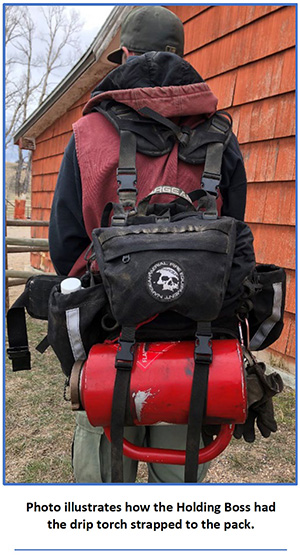The Regional Forester of the U.S. Forest Service’s Northern Region, Leanne Marten, has ordered an immediate pause on all prescribed fires within the region, which encompasses Montana, North Dakota, and Northern Idaho. In an April 19 memo, she described the reason:
In the last week and a half we have had reported four burn injuries of Northern Region employees, two very serious resulting in 3rd degree burns and surgery. Thankfully employees are recovering well.
As I mentioned on our call this morning, I am directing an immediate pause on all prescribed burns in the Northern Region until further notification from me. Each Forest Supervisor and Director are to immediately have a safety stand down with all employees to have a dialogue and assessment on where people are at and whether we are in the place with everything else going on in the world to safely move forward with this program of work.
Forest Supervisors were directed to report back by April 23 about the results of the discussions and their recommendations going forward.
One of the injuries resulted from the collar popping off a drip torch that was being carried strapped to a Forestry Technician’s pack. All of the fuel spilled onto the person’s legs and quickly ignited.
Here is an excerpt from the Rapid Lesson Sharing document dated April 13, 2021:

After the test burn for the Clear Creek Aspen Prescribed Fire was completed, blacklining operations began. The Holding Boss, with 17 years of experience, had a drip torch securely strapped to his pack, as is commonly practiced to supplement torches for the ignition crew. (See photo on left.) Fuel was not leaking from the torch.
As blackline operations continued, the brass locking ring and torch assembly simultaneously popped off the drip torch—making a noticeable audible sound. This action caused all the burn fuel to dump out at once, soaking the Holding Boss’ Nomex pants and boots.
This fuel instantaneously combusted, igniting the Holding Boss’ saturated clothing from the waist down.
The Holding Boss immediately dropped to the ground and attempted to roll. However, with his pack still on, he had limited mobility to do so. In addition, the drip torch’s burning tank was still connected to the pack.
These actions combined to ignite additional fuel in close proximity to the Holding Boss.
Difficulty in Suppressing Flames
All resources in the area immediately tried to assist the Holding Boss by trying to smother the flames on his legs with gloved hands. They removed the pack and poured water from their canteens to suppress the flames.
However, with the amount of fuel that was involved, efforts to put the flames out were not immediately effective.
While difficult to estimate, the amount of time it took to suppress the flames is estimated to be from 30 seconds to one minute.
Air Ambulance Extracts Holding Boss
The on-site EMT assessed the Holding Boss. The initial diagnosis included 2nd and 3rd degree burns on both legs.
The immediate extraction of the Holding Boss was done by air ambulance. Within 45 minutes of this burn incident the patient had been loaded into the air ambulance and was en route to the hospital.
Lessons and Follow-Up
- Despite no indications of leaking, the drip torch locking ring was able to pop off, jettisoning most of the fuel from the tank. Upon initial examination of the drip torch, the locking ring used does not appear to be from the same manufacturer as the rest of the torch
- The drip torch involved in this incident is being sent to the National Technology and Development Program (NTDP) for further inspection
- The local unit has started to examine their drip torch inventory to ensure that the components from each torch are from the same manufacturer.
This has Happened Here Before
In the aftermath of this drip torch burn injury incident, via follow-up conversations in this dispatch zone, it has been learned that at least one other locking ring has popped off a drip torch being used during prescribed fire activities this spring.
The 10-second video below shows how this may occur:
Lessons from a Similar Event: Caldwell Fire Burn Injury
A fuel can in the bed of a pickup caught fire. In the process of removing the fuel can from the truck, fuel spilled on a firefighter’s pants and ignited. He climbed out of the truck and attempted to stop, drop, and roll on the pavement to extinguish the flames on his pant leg. Rolling on the pavement didn’t work, so he stood up, stepped to the road shoulder and rolled in the dirt, finally extinguishing the fire.
From this FLA: Actions to Take to Extinguish Burning Fuel on Pants
“Stop, drop, and roll” does not readily extinguish burning fuel on Flame Resistant clothing. Additionally, it appears that attempting to swat or pat out burning fuel can increase the fire intensity. There are some actions that can be taken to extinguish burning fuel on Flame Resistant clothing. However, these actions require human performance in very stressful situations.
- Unbuckle and remove pants down to ankles or below boots. This reduces flame lengths and removes the heat from next to the skin, allowing the individual to extinguish the flames away from the legs. This method is preferred for large areas of burning fuel on pants.
- Use a water bottle to pour on the flames to extinguish the burning fuel.
- Drop to knees
Here is a video from the National Technology Development Program showing findings related to fuel igniting on Nomex pants:
(end of Rapid Lesson Sharing report)
Drip torches are carried strapped onto firefighters’ packs in other locations as well.


